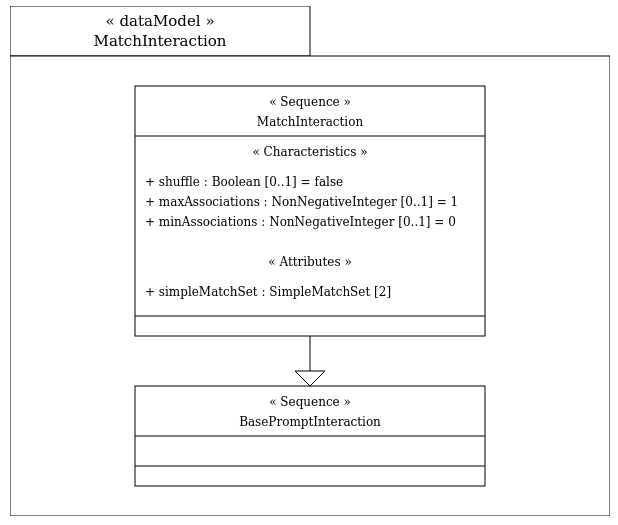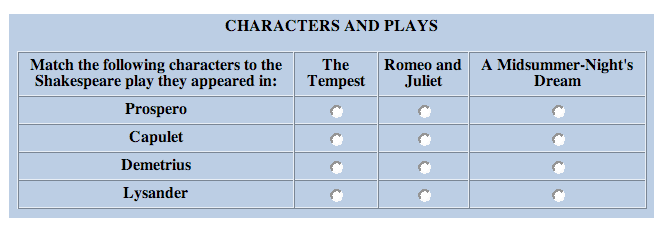Match Interaction (QTI)
A match interaction is a blockInteraction that presents candidates with two sets of choices and allows them to create associates between pairs of choices in the two sets, but not between pairs of choices in the same set.
Further restrictions can still be placed on the allowable associations using the matchMax attribute of the choices.
The matchInteraction must be bound to a response variable with base-type directedPair and either single or multiple cardinality. The relevant classes are:
Data Model

Example

<assessmentItem xsi:schemaLocation="http://www.imsglobal.org/xsd/imsqti_v2p2 http://www.imsglobal.org/xsd/qti/qtiv2p2/imsqti_v2p2p2.xsd" identifier="match" title="Characters and Plays" adaptive="false" timeDependent="false">
<responseDeclaration identifier="RESPONSE" cardinality="multiple" baseType="directedPair">
<correctResponse>
<value>C R</value>
<value>D M</value>
<value>L M</value>
<value>P T</value>
</correctResponse>
<mapping defaultValue="0">
<mapEntry mapKey="C R" mappedValue="1"/>
<mapEntry mapKey="D M" mappedValue="0.5"/>
<mapEntry mapKey="L M" mappedValue="0.5"/>
<mapEntry mapKey="P T" mappedValue="1"/>
</mapping>
</responseDeclaration>
<outcomeDeclaration identifier="SCORE" cardinality="single" baseType="float"/>
<itemBody>
<matchInteraction responseIdentifier="RESPONSE" shuffle="true" maxAssociations="4">
<prompt>
Match the following characters to the Shakespeare play they appeared in:
</prompt>
<simpleMatchSet>
<simpleAssociableChoice identifier="C" matchMax="1">Capulet</simpleAssociableChoice>
<simpleAssociableChoice identifier="D" matchMax="1">Demetrius</simpleAssociableChoice>
<simpleAssociableChoice identifier="L" matchMax="1">Lysander</simpleAssociableChoice>
<simpleAssociableChoice identifier="P" matchMax="1">Prospero</simpleAssociableChoice>
</simpleMatchSet>
<simpleMatchSet>
<simpleAssociableChoice identifier="M" matchMax="4">A Midsummer-Night's Dream</simpleAssociableChoice>
<simpleAssociableChoice identifier="R" matchMax="4">Romeo and Juliet</simpleAssociableChoice>
<simpleAssociableChoice identifier="T" matchMax="4">The Tempest</simpleAssociableChoice>
</simpleMatchSet>
</matchInteraction>
</itemBody>
<responseProcessing template="http://www.imsglobal.org/question/qti_v2p2/rptemplates/map_response"/>
</assessmentItem>
This time the candidate’s response is declared to have directedPair because the task involves pairing up choices from a source set into a target set. In this case characters from plays with the names of the plays from which they are drawn.
Notice that matchMax on the characters is one because each character can be in only one play (in fact, Shakespeare often reused character names but we digress) but it is four on the plays because each play could contain all the characters.
For example, Demetrius and Lysander were both in A Midsummer-Night’s Dream, so in the correct response that play has two associations. In the mapping used for response processing these two associations have been awarded only a half a mark each.